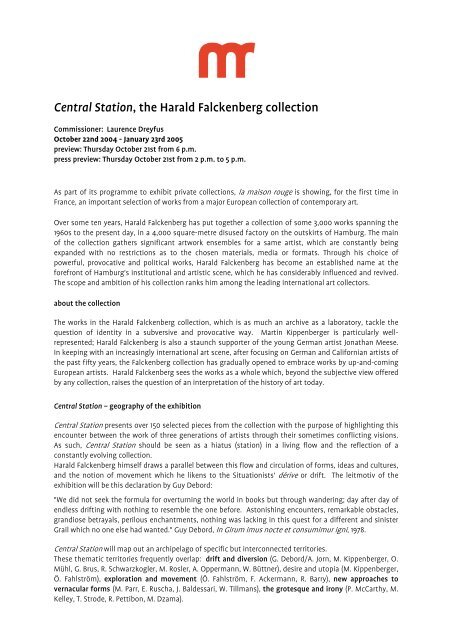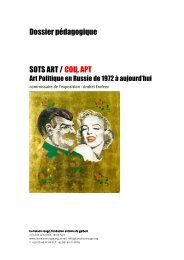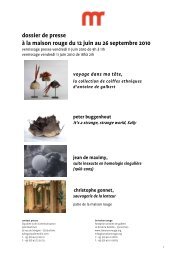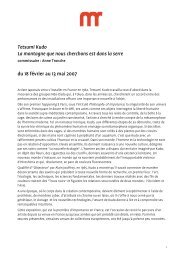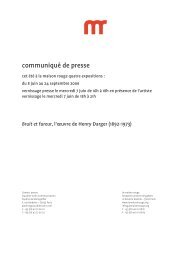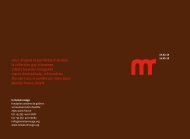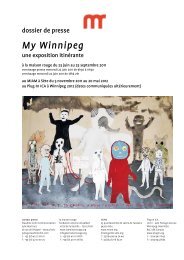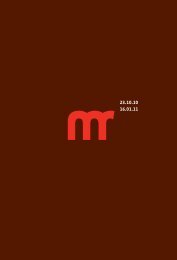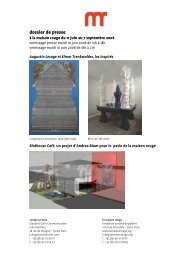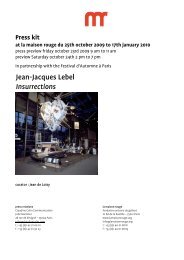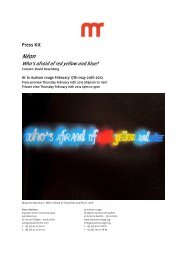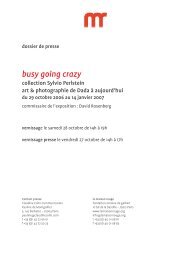Central Station, the Harald Falckenberg collection - La maison rouge
Central Station, the Harald Falckenberg collection - La maison rouge
Central Station, the Harald Falckenberg collection - La maison rouge
Create successful ePaper yourself
Turn your PDF publications into a flip-book with our unique Google optimized e-Paper software.
<strong>Central</strong> <strong>Station</strong>, <strong>the</strong> <strong>Harald</strong> <strong>Falckenberg</strong> <strong>collection</strong><br />
Commissioner: <strong>La</strong>urence Dreyfus<br />
October 22nd 2004 - January 23rd 2005<br />
preview: Thursday October 21st from 6 p.m.<br />
press preview: Thursday October 21st from 2 p.m. to 5 p.m.<br />
As part of its programme to exhibit private <strong>collection</strong>s, la <strong>maison</strong> <strong>rouge</strong> is showing, for <strong>the</strong> first time in<br />
France, an important selection of works from a major European <strong>collection</strong> of contemporary art.<br />
Over some ten years, <strong>Harald</strong> <strong>Falckenberg</strong> has put toge<strong>the</strong>r a <strong>collection</strong> of some 3,000 works spanning <strong>the</strong><br />
1960s to <strong>the</strong> present day, in a 4,000 square-metre disused factory on <strong>the</strong> outskirts of Hamburg. The main<br />
of <strong>the</strong> <strong>collection</strong> ga<strong>the</strong>rs significant artwork ensembles for a same artist, which are constantly being<br />
expanded with no restrictions as to <strong>the</strong> chosen materials, media or formats. Through his choice of<br />
powerful, provocative and political works, <strong>Harald</strong> <strong>Falckenberg</strong> has become an established name at <strong>the</strong><br />
forefront of Hamburg's institutional and artistic scene, which he has considerably influenced and revived.<br />
The scope and ambition of his <strong>collection</strong> ranks him among <strong>the</strong> leading international art collectors.<br />
about <strong>the</strong> <strong>collection</strong><br />
The works in <strong>the</strong> <strong>Harald</strong> <strong>Falckenberg</strong> <strong>collection</strong>, which is as much an archive as a laboratory, tackle <strong>the</strong><br />
question of identity in a subversive and provocative way. Martin Kippenberger is particularly wellrepresented;<br />
<strong>Harald</strong> <strong>Falckenberg</strong> is also a staunch supporter of <strong>the</strong> young German artist Jonathan Meese.<br />
In keeping with an increasingly international art scene, after focusing on German and Californian artists of<br />
<strong>the</strong> past fifty years, <strong>the</strong> <strong>Falckenberg</strong> <strong>collection</strong> has gradually opened to embrace works by up-and-coming<br />
European artists. <strong>Harald</strong> <strong>Falckenberg</strong> sees <strong>the</strong> works as a whole which, beyond <strong>the</strong> subjective view offered<br />
by any <strong>collection</strong>, raises <strong>the</strong> question of an interpretation of <strong>the</strong> history of art today.<br />
<strong>Central</strong> <strong>Station</strong> – geography of <strong>the</strong> exhibition<br />
<strong>Central</strong> <strong>Station</strong> presents over 150 selected pieces from <strong>the</strong> <strong>collection</strong> with <strong>the</strong> purpose of highlighting this<br />
encounter between <strong>the</strong> work of three generations of artists through <strong>the</strong>ir sometimes conflicting visions.<br />
As such, <strong>Central</strong> <strong>Station</strong> should be seen as a hiatus (station) in a living flow and <strong>the</strong> reflection of a<br />
constantly evolving <strong>collection</strong>.<br />
<strong>Harald</strong> <strong>Falckenberg</strong> himself draws a parallel between this flow and circulation of forms, ideas and cultures,<br />
and <strong>the</strong> notion of movement which he likens to <strong>the</strong> Situationists' dérive or drift. The leitmotiv of <strong>the</strong><br />
exhibition will be this declaration by Guy Debord:<br />
"We did not seek <strong>the</strong> formula for overturning <strong>the</strong> world in books but through wandering; day after day of<br />
endless drifting with nothing to resemble <strong>the</strong> one before. Astonishing encounters, remarkable obstacles,<br />
grandiose betrayals, perilous enchantments, nothing was lacking in this quest for a different and sinister<br />
Grail which no one else had wanted." Guy Debord, In Girum imus nocte et consumimur igni, 1978.<br />
<strong>Central</strong> <strong>Station</strong> will map out an archipelago of specific but interconnected territories.<br />
These <strong>the</strong>matic territories frequently overlap: drift and diversion (G. Debord/A. Jorn, M. Kippenberger, O.<br />
Mühl, G. Brus, R. Schwarzkogler, M. Rosler, A. Oppermann, W. Büttner), desire and utopia (M. Kippenberger,<br />
Ö. Fahlström), exploration and movement (Ö. Fahlström, F. Ackermann, R. Barry), new approaches to<br />
vernacular forms (M. Parr, E. Ruscha, J. Baldessari, W. Tillmans), <strong>the</strong> grotesque and irony (P. McCarthy, M.<br />
Kelley, T. Strode, R. Pettibon, M. Dzama).
selection of featured works<br />
- Franz Ackermann, "White Crossing", 2001 and "Mental Maps", 2000-2002 (wall installation).<br />
- Anna Oppermann, "Problemlösungsauftrag an Künstler (Raumproblem)", 1978-1984 (installation),<br />
German artist showing for <strong>the</strong> first time in France.<br />
- Guy Debord / Asger Jorn, "Mémoires", 1958 and "Mémoires", 1959.<br />
- Martin Kippenberger, "Sozialkistentransporter – Transport for social care boxes", 1989 (sculpture).<br />
- Thomas Hirschhorn, "Bernsteinzimmer", 1998-1999 (installation).<br />
- Wolfgang Tillmans, "Protest and Survive", 1991-2000 (installation, 64 photographic elements).<br />
- Bjarne Melgaard, commission in situ, 2004.<br />
- Nam June Paik, "Video Scooter", 1994.<br />
- Martin Parr "Common Sense", 1999 (350 colour photos).<br />
- Jonathan Meese "<strong>La</strong> Chambre de Balthys", 2001 (installation).<br />
- Peter Welz, "whenever on on on nohow on/airdrawing", 2003, filmed performance with William<br />
Forsy<strong>the</strong> (5 video projectors).<br />
biographies<br />
<strong>Harald</strong> <strong>Falckenberg</strong> was born in 1943 and is President of <strong>the</strong> Hamburg Kunstverein. He read law at<br />
Freibourg, Berlin and Hamburg, from where he graduated as a doctor in law. Since 1979 he has been<br />
Managing Director of a company in <strong>the</strong> oil sector.<br />
He is also an Honorary Judge at <strong>the</strong> Hamburg Constitutional Court.<br />
<strong>La</strong>urence Dreyfus, born in 1969, is an independent curator tasked with exhibitions of private contemporary<br />
art <strong>collection</strong>s at la <strong>maison</strong> <strong>rouge</strong>. In 1997 she toured Europe showing works by 45 artists in a car. She went<br />
on to stage "<strong>La</strong> Barge des Désirs", three floating exhibitions on <strong>the</strong> River Rhone in Lyons. A regular<br />
contributor since 1998 to Beaux Arts magazine with a column on culinary art, she curated exhibitions at<br />
<strong>the</strong> Contemporary Art Biennial in Lyons and <strong>the</strong> first Prague Biennial in 2003. She is also behind Art Digital<br />
Video, a travelling exhibition for <strong>the</strong> Association Française d'Action Artistique (2003-2006).<br />
publications<br />
For each of <strong>the</strong> <strong>collection</strong>s it exhibits, la <strong>maison</strong> <strong>rouge</strong> co-publishes with Gilles Fage a catalogue as part of<br />
its <strong>collection</strong>s privées series.<br />
<strong>Central</strong> <strong>Station</strong>, <strong>the</strong> <strong>Harald</strong> <strong>Falckenberg</strong> <strong>collection</strong> is <strong>the</strong> second in this series.<br />
160 illustrated pages in French and English with texts by <strong>La</strong>urence Dreyfus, <strong>Harald</strong> <strong>Falckenberg</strong> and Sophie<br />
Delpeux, plus an interview with Hans-Ulrich Obrist.<br />
pratical<br />
opening times:<br />
Wednesday to Sunday – 11 a.m. to 7 p.m.<br />
late-night Thursday until 9 p.m.<br />
admission:<br />
full price:6,50 euros<br />
concessions:3,50 euros<br />
Contact presse<br />
la <strong>maison</strong> <strong>rouge</strong><br />
Claudine Colin Communication<br />
fondation antoine de galbert<br />
5, rue Barbette – 75003 Paris 10 bd de la bastille – 75012 Paris<br />
contact : Nathalie Marchal<br />
info@la<strong>maison</strong><strong>rouge</strong>.org<br />
t : +33 (0)1 42 72 60 01<br />
www.la<strong>maison</strong><strong>rouge</strong>.org<br />
f : +33 (0)1 42 75 50 23 t : +33 (0)1 40 01 08 81<br />
nathalie@claudinecolin.com f : +33 (0)1 40 01 08 83


